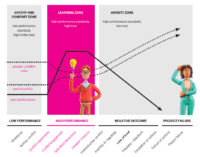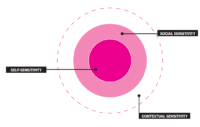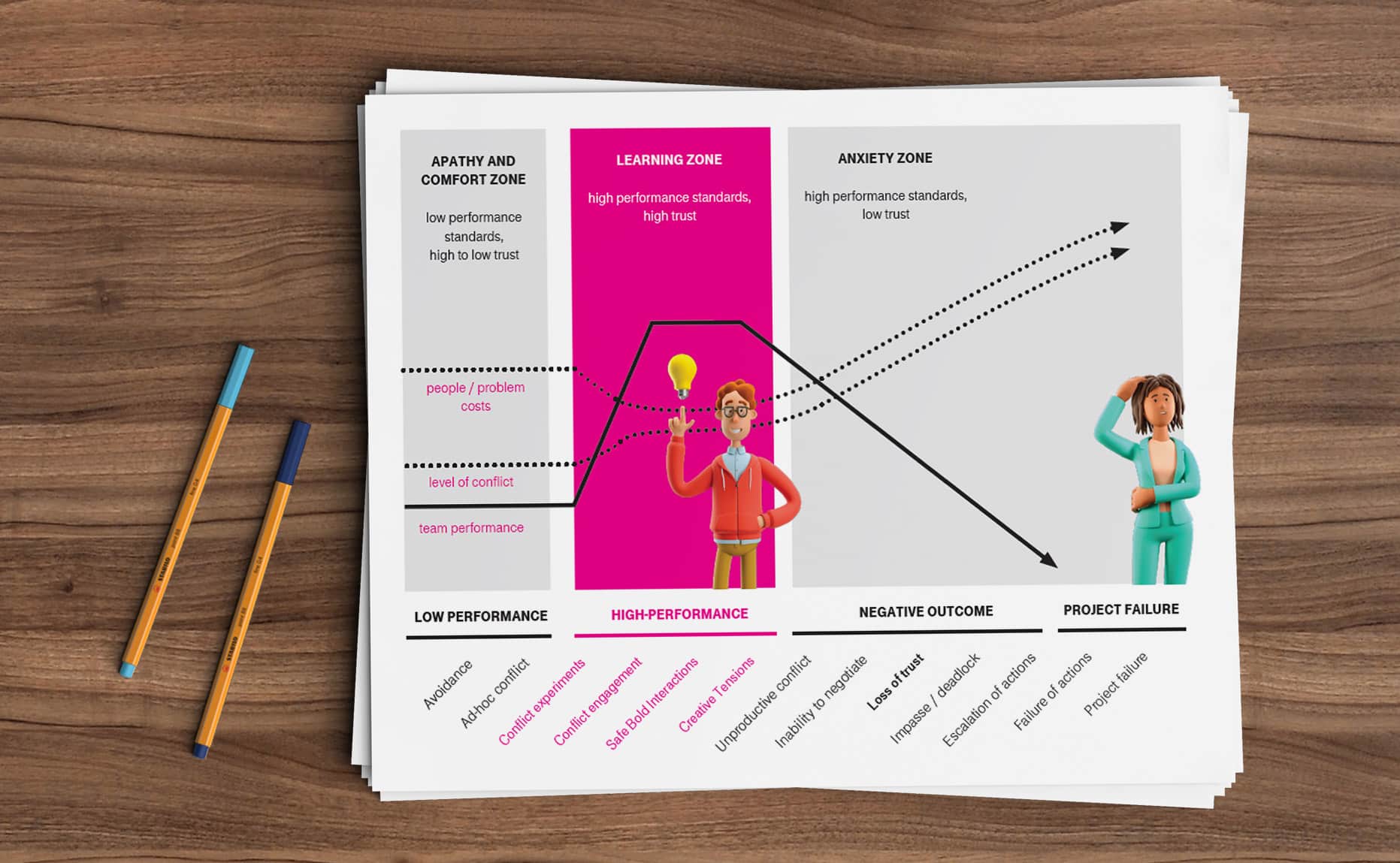TRUST AND PSYCHOLOGICAL SAFETY – Part 3.
Whether team members feel psychologically safe has a strong impact on the team’s performance, as it forms the basis for innovation, motivation, commitment and creativity.
- Part 1: Trust
- Part 2: Psychological safety
- Part 3: Team performance
Part 3: Team performance
In her book “The Fearless Organization”, Amy Edmondson explains the influence of psychological safety in combination with responsibility and motivation and what performance can be expected as a result.
On a spectrum – from little tension to too much tension in a team – the performance requirement and the necessary level of trust can be well represented.
If there is little or no tension in the team, conflicts are avoided or impulsive ad hoc conflicts that may have been simmering under the surface for a long time.
In this apathy and comfort zone, the team performs poorly and has a low level of conflict.
With a high level of trust, tensions can be harnessed to achieve better results.
Creative tension – for example, juxtaposing different perspectives – can lead to new insights.
In a safe environment, people look for the causes of mistakes rather than the culprits in order to learn from them.
In teams with high tensions and little trust, unproductive conflicts, inability to act or even loss of trust can occur.
Projects can be maneuvered into a situation from which there is no way out, up to and including the failure of the project or individual actions.
In this fear zone, team performance decreases and the cost of problems increases.
Only trust enables top performance, because this is the only way to guarantee a high standard of performance and sustainability at the same time.

Would you like to assess yourself and your team on this spectrum?
Then answer the following questions to get started.
What can be observed in teams with high psychological security?
In teams with a high level of psychological safety, there is a climate in which different perspectives are valued.
Team members interact in an inclusive, trusting and respectful atmosphere where no one is afraid to admit mistakes.
Team members talk openly about their feelings and needs and build strong personal relationships with each other.
The atmosphere is characterized by mutual feedback and appreciation for actions, progress and/or results.
There are clear procedures and rituals for dealing with conflicts within the team and clear behavioral expectations among each other.
The aim is to negotiate which values are important to the team and how this is reflected in behavior, i.e. the joint development of a team culture and identity.
How does each individual feel it in everyday life?
And what can each individual do?
Everyone feels psychologically safe in everyday life when they do not have to fear rejection, ignorance or humiliation when they ask a question, share an idea, express a concern or make a mistake.
In team meetings, speaking time does not depend on status, but on the perspective that is brought, and so it becomes clear how the differences in the team are valued.
The team shows understanding for each other, even when it is possible to dispute the matter.
The responsibility for creating psychological safety lies with each individual team member.
In addition to many individual trusting relationships in the team, this also includes inclusion and sensitivity in their various forms.
Sensitivity to oneself, others and the context has a positive effect on the dynamics of social interactions and is an integrative aspect of team membership.
The perception and regulation of emotions in oneself and in interpersonal relationships is referred to as emotional intelligence.

Self-sensitivity and regulation …
… is the ability to feel our own emotions and understand their origins.
The better we understand the causes of our feelings, the better we can react to them and articulate our needs.
It is about the perception and acceptance of one’s own emotions in order to articulate and regulate them.
This promotes authenticity when people feel encouraged to be themselves and express themselves at work.
Self-compassion and self-esteem are supportive attitudes for self-sensitivity.
What you can do:
Social sensitivity …
… is the ability to understand, be aware of and vicariously experience the feelings, thoughts and experiences of others (either past or present) without fully communicating them in an objectively explicit way.
In addition, one should recognize the impact of one’s actions on others (e.g. when a colleague needs to concentrate and is aware that a loud discussion in the same room can be disruptive and therefore moves to another room).
Social sensitivity relates to others and promotes a sense of belonging when individuals feel connected to others at work.
Acceptance includes valuing coworkers, inclusion and diversity.
What you can do:
Context sensitivity …
… (e.g. in relation to the situation or the organization) is the ability to understand not only the self and team level, but also the context in which the situation takes place, e.g. not having a critical conversation in an open-plan office or seeing similar patterns in the group also in the organization.
What you can do:

